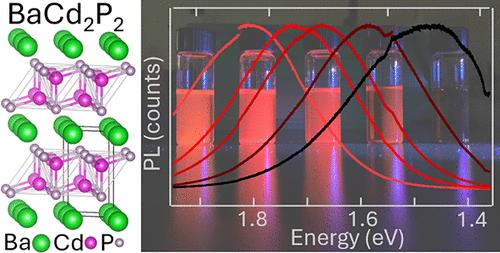光电用zintl相BaCd2P2量子点的合成与表征
IF 16
1区 材料科学
Q1 CHEMISTRY, MULTIDISCIPLINARY
引用次数: 0
摘要
我们展示了尺寸控制,高光学质量的zintl相BaCd2P2胶体量子点(QDs)的生长,这是一种新兴的半导体吸收/发射红色,并预测具有良好的缺陷化学。通过将磷前驱体热注入溶解Ba和Cd前驱体的溶液中来生长量子点。吸光度和光致发光(PL)可通过生长温度调节,并显示出1.47至1.81 eV的带隙,根据尺寸的不同,其带隙范围为3至9 nm。选择区域电子衍射确定BaCd2P2量子点在P3′m1空间群中结晶,与本体材料相同。拉曼光谱、粉末x射线衍射和x射线荧光研究进一步证实了BaCd2P2的量子点与晶体相体材料的量子点相匹配。高光电质量是通过量化长寿命光激发载流子(平均加权约160 ns)来评估的,这是由时间分辨PL光谱和亮红色可见发射(PL量子产率约21%)确定的,尽管没有复杂的表面钝化。此外,通过固态配体交换协议展示了薄膜制造的演示。这种合成方案使研究人员能够探索和利用BaCd2P2锌相量子点,以及邻近的组合物,用于各种光电应用,这些应用是由它们的半导体特性实现的。本文章由计算机程序翻译,如有差异,请以英文原文为准。

Synthesis and Characterization of Zintl-Phase BaCd2P2 Quantum Dots for Optoelectronic Applications
We demonstrate the growth of size-controlled, high optical quality Zintl-phase BaCd2P2 colloidal quantum dots (QDs), an emerging semiconductor absorbing/emitting in the red and predicted to have favorable defect chemistry. The QDs are grown via hot injection of a phosphorus precursor into a solution of solubilized Ba and Cd precursors. The absorbance and photoluminescence (PL) are tunable via growth temperature and show a bandgap ranging from 1.47 to 1.81 eV, depending on the size, which ranges from 3 to 9 nm based on electron microscopy. Selected area electron diffraction is used to determine that the BaCd2P2 QDs crystallize in the P3̅m1 space group, same as the bulk material. Raman spectroscopy, powder X-ray diffraction, and X-ray fluorescence studies further confirm that BaCd2P2 QDs match those of the crystalline phase bulk material. The high optoelectronic quality is assessed by quantification of long-lived photoexcited carriers (∼160 ns average weighting), as determined by time-resolved PL spectroscopy, and bright red visible emission (∼21% PL quantum yield) despite no complex surface passivation. Furthermore, a demonstration of thin-film fabrication is shown via a solid state ligand exchange protocol. This synthetic protocol enables researchers to explore and utilize BaCd2P2 Zintl-phase QDs, as well as adjacent compositions, for a variety of optoelectronic applications enabled by their semiconducting properties.
求助全文
通过发布文献求助,成功后即可免费获取论文全文。
去求助
来源期刊

ACS Nano
工程技术-材料科学:综合
CiteScore
26.00
自引率
4.10%
发文量
1627
审稿时长
1.7 months
期刊介绍:
ACS Nano, published monthly, serves as an international forum for comprehensive articles on nanoscience and nanotechnology research at the intersections of chemistry, biology, materials science, physics, and engineering. The journal fosters communication among scientists in these communities, facilitating collaboration, new research opportunities, and advancements through discoveries. ACS Nano covers synthesis, assembly, characterization, theory, and simulation of nanostructures, nanobiotechnology, nanofabrication, methods and tools for nanoscience and nanotechnology, and self- and directed-assembly. Alongside original research articles, it offers thorough reviews, perspectives on cutting-edge research, and discussions envisioning the future of nanoscience and nanotechnology.
 求助内容:
求助内容: 应助结果提醒方式:
应助结果提醒方式:


